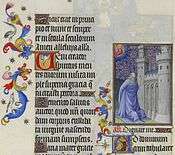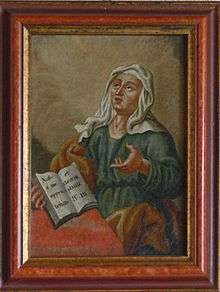Psalm 119
Psalm 119 (Greek numbering: Psalm 118) is the longest psalm as well as the longest chapter in the Bible. It is referred to in Hebrew by its opening words, "Ashrei temimei derech" ("happy are those whose way is perfect"). It is the prayer of one who delights in and lives by the Torah, the sacred law. With its 176 verses, Psalm 119 has more verses than 14 Old Testament Books and 17 New Testament Books.
Literary features
This psalm is one of about a dozen alphabetic acrostic poems in the Bible. Its 176 verses are divided into twenty-two stanzas, one stanza for each letter of the Hebrew alphabet; within each stanza, each of the eight verses begins (in Hebrew) with that letter.[1] The name of God (Yahweh/Jehovah) appears twenty-four times.

Employed in almost (but not quite) every verse of the psalm is a synonym for the Torah, such as dabar ("word, promise"), mishpatim ("rulings"), etc.[1]
The acrostic form and the use of the Torah words constitute the framework for an elaborate prayer. The grounds for the prayer are established in the first two stanzas (alef and beth): the Torah is held up as a source of blessing and right conduct, and the psalmist pledges to dedicate himself to the law. The prayer proper begins in the third stanza (gimel, v. 17). Like many other psalms, this prayer includes dramatic lament (e.g. verses 81–88), joyous praise (e.g. verses 45–48) and prayers for life, deliverance and vindication (e.g. verses 132–134). What makes Psalm 119 unique is the way that these requests are continually and explicitly grounded in the gift of the Torah and the psalmist's loyalty to it.
The first and fifth verses in a stanza often state the same theme followed by a statement of opposition, affliction or conflict, and the final (eighth) verse tends to be a transition introducing the next stanza. Several dozen prayers are incorporated into the Psalm, e.g. "Open my eyes that I may behold wondrous things out of your law." Themes include opposition by man, affliction, delight in the law and the goodness of God, which sometimes run into each other: "I know, O Lord, that your rules are righteous, and that in faithfulness you have afflicted me" (v. 75), or "If your law had not been my delight, I would have perished in my affliction" (v. 92). The Psalmist at times seems to appeal to God's sovereignty, "inclining his heart to the law" in contrast to the Psalmist saying "I incline my heart." Thus, God as sovereign is invoked in v.36 "Incline my heart to your testimonies", while the Psalmist also takes personal responsibility in v. 112, "I incline my heart to perform your statutes forever." It ends with an appeal to God to seek his servant who strayed.
Uses
Judaism
- Verse 66 is recited prior to the Shofar blowing on Rosh Hashanah.[2]
- Verse 72 is found in Pirkei Avot Chapter 6, no. 9.[3]
- Verses 89–91 are recited during the blessings before the Shema on the second day of Rosh Hashanah.[4]
- Verse 99 is found in Pirkei Avot Chapter 4, no. 1.[5]
- Verse 108 is recited prior to the Shofar blowing on Rosh Hashanah.[2]
- Verse 122 is recited prior to the Shofar blowing on Rosh Hashanah.[2]
- Verse 142 is part of Uva Letzion[6] and Tzidkatcha.[7]
- Parts of verses 153–154 comprise the blessing Re'eh of the weekday Amidah.[8]
- Verse 160 is recited prior to the Shofar blowing on Rosh Hashanah.[2]
- Verse 162 is recited prior to the Shofar blowing on Rosh Hashanah.[2]
- Verse 165 is part of Talmud Berachos 64a.[9]
- Verses 166, 162, and 165 are recited in that order by the mohel at a brit milah.[10]
Eastern Orthodox

The psalm (118 in the Septuagint) figures prominently in the worship of the Orthodox Church. There is a tradition that King David used this psalm to teach his young son Solomon the alphabet—but not just the alphabet for writing letters: the alphabet of the spiritual life.
The psalm comprises an entire Kathisma (division of the Psalter) in Orthodox liturgical practice. In Orthodox monasteries it is read daily at the Midnight Office: "At midnight I arose to give thanks unto Thee for the judgments of Thy righteousness" (v. 62). It is read at Matins on Saturdays and is also chanted on many Sundays throughout the year. A major portion of Matins on Holy Saturday comprises chanting the entire psalm as a threnody, divided into three parts (stases) with Praises (Greek: Enkomia) interspersed between each verse. This chanting is done as all stand holding candles around a catafalque over which has been placed the Epitaphion (a shroud embroidered with the figure of Christ laid out for burial).
The psalm is also chanted with special solemnity at Orthodox funeral services and on the various All-Souls Days occurring throughout the year, with "Alleluia" chanted between each verse. Its use here is a reflection of the chanting done on Holy Saturday. "Alleluia" is chanted between the verses to signify the victory over death accomplished by Christ's death and Resurrection, and the eternal reward promised to the faithful.
The Psalm contains several dozen prayers and several themes run through it. God's goodness in the midst of affliction and delight in God's law. God is seen sovereignly "inclining ones heart" and the Psalmist "inclines his heart" to the statutes.
Catholic

This psalm was chosen by St. Benedict of Nursia, for Sunday services from his Benedictine rule of 530AD. According to the time of reunification, the first four divisions were executed at premium. The following three sections were respectively awarded to third, sext and none. The next day, ie on Monday, the remaining nine divisions were divided three by three, the third, sext and noners.[11]
Currently, all the twenty-two huitains of Psalm 119 is sung or recited in the Liturgy of the Hours. The huitains I, II, III, IV and V are respectively the Office of midday Tuesday, Wednesday, Thursday, Friday and Saturday of the first semaine.[12] The huitains VI, VII, VIII, IX, X and XI are placed at the office of midday of the second week, respectively on Monday, Tuesday, Wednesday, Thursday, Friday and Saturday.
The huitains XII, XIII, XIV, XV, XVI are placed at the office of midday of the third week, respectively on Monday, Tuesday, Wednesday, Thursday and Saturday. The huitains XVII, XVIII, XIX, XX, XXI and XXII are placed at the office of midday the fourth week, respectively on Monday, Tuesday, Wednesday, Thursday, Friday and Saturday. The XIV stanza is sung or recited Vespers Saturday of the second week, and the lauds XIX Saturday of the first and third weeks.
Moreover, Psalm 119 is read in part at Sunday Mass of the 17th Sunday in Ordinary Time of the Year.[13]
Musical settings
- Psalm 119:1 was set to music by Charles Villiers Stanford.
- Psalm 119:18 inspired the hymn Open My Eyes, That I May See by Clara H. Scott.[14]
- Psalm 119:33–38 was set to music by William Byrd as Teach Me, O Lord.
- Psalm 119:89 is a popular Nigerian praise song.
- Psalm 119:105 was set to music by Amy Grant.
- Psalm 119:1–176 was completed in 1671 by Heinrich Schütz.
- Czech composer Antonín Dvořák set verses 114, 117, 119 and 120 to music in his Biblical Songs (1894).
A complete English version of Psalm 119 from the King James Bible was completed by Frederick Steinruck, Michael Misiaszek, and Michael Owens.
The Psalm is put to music in The Book of Psalms for Worship, published by Crown and Covenant Publications.[15]
Structure
Psalm 119 is one of several acrostic poems found in the Bible. Its 176 verses are divided into 22 stanzas, one for each of the 22 characters that make up the Hebrew alphabet. In the Hebrew text, each of the eight verses of each stanza begins with the same Hebrew letter. This feature was not maintained in the Septuagint, except that many manuscripts have placed at the beginning of each stanza the name of the corresponding Hebrew letter (eg for aleph first stanza, the last tav).[16] Because of this structure, the Psalm 118/119 was one of the main occurrences of the Hebrew alphabet in the texts of the medieval West and moderne.[11]
References
- 1 2 Murphy, Roland E. (2000). The Gift of the Psalms. Hendrickson. ISBN 1-56563-474-8.
- 1 2 3 4 5 The Complete Artscroll Machzor for Rosh Hashanah page 435
- ↑ The Complete Artscroll Siddur page 587
- ↑ The Complete Artscroll Machzor for Rosh Hashanah page 269
- ↑ The Complete Artscroll Siddur page 565
- ↑ The Complete Artscroll Siddur page 157
- ↑ The Complete Artscroll Siddur page 525
- ↑ The Complete Artscroll Siddur page 102
- ↑ The Complete Artscroll Siddur page 479
- ↑ The Complete Artscroll Siddur page 209
- 1 2 Lyse Schwarzfuchs, Le livre hébreu à Paris au XVIe siècle : inventaire chronologique, Paris, Bibliothèque nationale de France, 2004.
- ↑ Le cycle principal des prières liturgiques se déroule sur quatre semaines.
- ↑ Le cycle des lectures des messes du dimanche se déroule sur trois ans.
- ↑ Donovan, Richard Niell (2007). "Hymn Story: Open My Eyes". Lectionary.org.
- ↑ http://www.crownandcovenant.com/The_Book_of_Psalms_for_Worship_p/cm101.htm
- ↑ La Chaîne palestinienne sur le Psaume 118, introduction, texte grec critique et traduction par Marguerite Harl, Paris, éd. du Cerf, 1972, t. 1, p. 106.
External links
- Tehillim - Psalm 119 (Judaica Press) translation with Rashi's commentary at Chabad.org
- Yemenite Jewish reading of Psalm 119 by Aharon Amram (published by http://www.nosachteiman.co.il/?CategoryID=725&ArticleID=3078)
- Psalm 119 (New Skete translation)
- Psalm 118 (LXX numbering) Holy Transfiguration Monastery translation
- Exposition of Psalm 119 by Charles Bridges, 1827 (Full Text - Public Domain)
- The Golden Alphabet: Exposition of Psalm 119 by Charles Spurgeon, 1887 (Full Text - Public Domain)
- Psalm 119 CD and Sheet Music by Susie Kimbrough
Further reading
- An Exposition of Psalm 119 by Charles Bridges (1794–1869), The Banner of Truth Trust, Edinburgh, 1974 (first published 1827) ISBN 0-85151-176-7
- In its original preface, Bridges stated that his purpose in writing on Psalm 119 was to 'furnish a correct standard of Evangelical sincerity for the habitual scrutiny of his own heart', corresponding to 'the several graces of the Christian system'
- Scott N. Callaham, "An Evaluation of Psalm 119 as Constrained Writing," Hebrew Studies 50 (2009): 121–135.